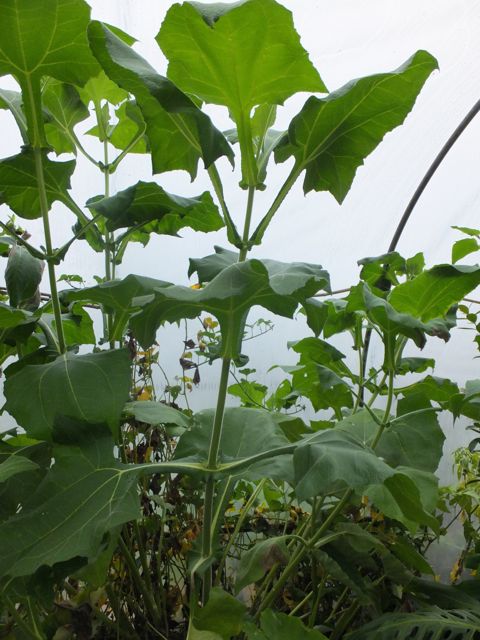 You need a generous greenhouse to freely accommodate Yacon as this can easily grow two, three or more metres high. Fortunately it can also be cut back down so you can squeeze one into a smaller space. But be warned this has expansionist tendencies and in small houses is best confined in a large tub where it will not be quite so exuberant.
You need a generous greenhouse to freely accommodate Yacon as this can easily grow two, three or more metres high. Fortunately it can also be cut back down so you can squeeze one into a smaller space. But be warned this has expansionist tendencies and in small houses is best confined in a large tub where it will not be quite so exuberant.
Originally grown in South America for the large edible tubers Yacon plants grow tall and much resemble Jerusalem artichokes, with different more attractively shaped leaves. They also have small yellow flowers and spread from knobbly tubers. These tubers grow as large as potatoes, watery and sweet, in South America the plethora of names shows many people like them.
Now I’m not much taken by them. However they are currently appearing all over the place, though I doubt this popularity will last. Anyway it is for an under-cover foliage plant I recommend Yacon (go on try the tubers, cooked or raw, you’ll see why, as with Jerusalem artichokes they cause an unpleasant flatulence).
Anyway for almost instant foliage, soft and pleasing, and lots of it, Yacon is brilliant and especially good in a cool frost free greenhouse or conservatory. It can even go outdoors in a warm garden as the tubers survive if really well protected with a mound of insulation. Almost the only problem, other than vigour, is Yacon does attract mealy bug. Indeed I use it as a trap plant, I wait till it has gathered a load then cut it back hard, the new shoots soon replace the old and look better anyway.
You can grow Yacon from the tubers sometimes sold in ethnic shops and also from plants sold through the post by seed companies. It is not the larger smooth skinned tubers (the ones best eaten) that grow best but the smaller knobbly knotty ones. Each small chunk of these with a bud will make a new plant so these are very easy to multiply and grow in almost any soil or compost.
If a plant is left in the same tub or spot for long the tuberous roots can become congested and will benefit from thinning and repotting every couple if years. As these plants are hungry feeders then this is a good idea anyway as you can give them rich new compost. Otherwise during the growing season add plenty of liquid feed to the huge quantities of water you will be giving them. Although a thirsty crop Yacon survives drought remarkably well, it prefers its compost on the drier side throughout winter unless kept warm and in growth.
Oh yes, it does have a Latin name, Smallianthus or Polymnia sonchifolia, the leaves have been used as fodder for stock and do indeed resemble giant sowthistles, and the stems have been cooked as vegetables.


